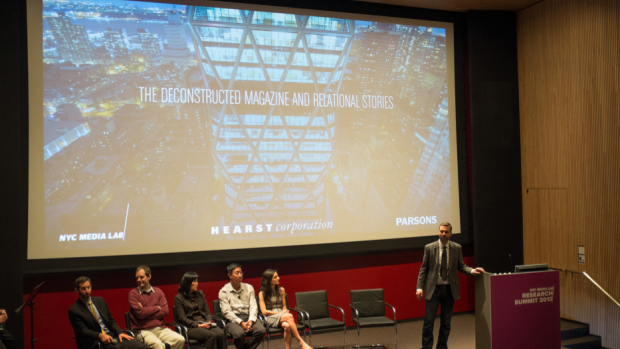NYC Media Lab Annual Research Summit Explores the Future of Media

The NYC Media Lab was founded two years ago in the hopes of building an open innovation environment where member companies could learn from one another and engage with cutting-edge researchers from New York City's universities. The lab values relationships over competitive advantage and the recent second annual research summit set out to explore how companies can engage with universities to shape the future of media. The summit featured some of the most future-looking collaborations being done in big data, broadband, networked storytelling, recruiting, video streaming, policy, crowd sourcing, and entrepreneurship.
The lab has made "significant strides over the past year," according to NYC Media Lab Marketing Manager Julia Evanczuk. "We have also successfully completed three seed research projects in conjunction with members of Hearst Corporation, Time Warner Cable, and Verizon."
And additional corporations are lining up to join in their success. The lab has signed seven new corporate members, including AT&T, ESPN, HBO, Hearst Corporation, NBCUniversal, Time Warner Cable, and Verizon.
TWC’s Chairman and CEO Glenn Britt delivered the keynote address at the research summit. Britt, who is retiring as CEO this year, reflected on his 40-year career in the cable industry. "[...] the most amazing thing to me," Britt said, "is that all the things the pioneers of the industry dreamt have come true, only bigger and better than people could have imagined."
Britt went on to say that the future of media depends on solving the four 'anys'. These were "any content, any device, anytime, anywhere." A great example of research addressing Britt's visions for an always-on internet is TWC's partnership with NYU–Poly Professor Justin Cappos, who is studying the potential impact that the 'internet of things' could have on broadband usage. Cappos wanted to know how disruptive it could be if all the things we have were suddenly web-enabled, for example, what if we all suddenly have smart eggs (that know when they go bad) in smart refrigerators (that know how many eggs are left and can recommend recipes). Watch this video to find out. Cappos also looked into the potential impact of 5g and fog computing.
Other results of NYC Media Lab's first round of seed research projects include The Hearst/Parsons collaboration on a deconstructed magazine. The team explored what a truly digital magazine -- with potentially unlimited content sources -- could be. What they created was an interface that connected people with content that breaks out of traditional media verticals, with the potential to reach previously untapped markets. Another high point of the summit was a student panel, hosted by WNYC's Manoush Zomorodi, in which students from Parsons, Columbia and NYU–Poly shared their views on work and careers with the executives in the audience. Columbia BA student Chris Mulligan said, "Loyalty's changed. It's not to a specific job or company, but to a career path." And NYU–Poly ECE PhD Bill Tian added "There are two ladders in a company, a technology ladder and a management ladder."
"It's clear that NYC's media companies recognize the power of university collaboration and emerging talent--but," says Evanczuk, "unlike the west coast, these kinds of relationships aren't embedded into our culture here. We're bringing value to NYC by building and strengthening those connections."
There is a lot to look forward to in 2013. In addition to pursuing seed projects with the lab's new corporate members they will also be rolling out fellowship program to foster talent from NYC's universities. And the lab will be hosting several more events, the first will be focused on organizing for innovation in early November.




